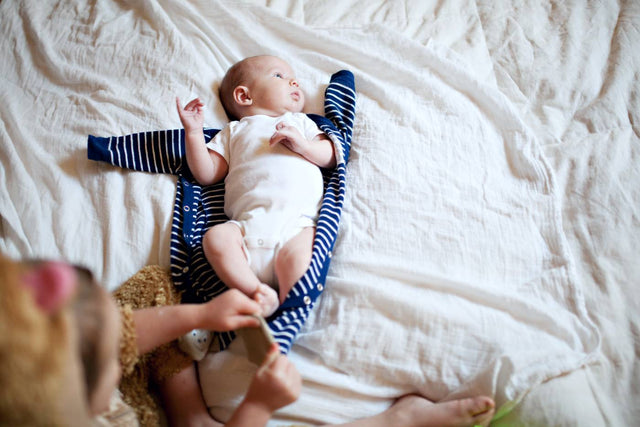4-Week-Old Baby Milestones

Four weeks isn’t “just” 4 weeks—it’s just about the 1-month birthday! Yay! That’s a huge milestone for both your baby and you. Whether it’s your first time or 10th, you’ve earned a huge pat on the back.
As you and your baby continue to get acquainted, you’ll understand them better and better. From predicting when your baby will be hungry to recognizing cues that they are getting sleepy, you’re starting to figure things out.
This fussing for no obvious reason peaks between 4 and 8 weeks. The word “colic” means stomach pain. Maybe 10% of fussy babies fuss because of a milk allergy and 2 to 3% fuss because of acid reflux. But, for most babies, we can easily tell that the fussing is not caused by tummy pain because they tend to calm with the sound of a hair drier, bouncing on the edge of the bed, or even car rides…and, of course, with the 5 S’s.
Many babies have fussing peaks in the early evening, the so-called “witching hour.” A key culprit of the witching hour is overstimulation. Your baby may be a good sport all day…but may hit their limit by sundown. Help them wind down by dimming the lights, using white noise, turning down other noises (TVs, etc), and crank up the 5 S’s to lull your baby into a more peaceful state.
4-Week-Old Baby Feeding Schedule
How much breastmilk should a 4-week-old baby eat?
A 4-week-old baby eats about 2 to 3 ounces of milk about every 2 to 3 hours. Breastfed babies nurse about eight to 12 times in a 24-hour period.
Your 4-Week-Old Baby’s Development
Senses Coming into Focus
As your baby begins to have clear wake and sleep periods, you get to play together more!
- Hearing is one of your baby’s sharpest senses. At this point and they love the sound of you speaking and singing…especially when you use a higher, more animated voice.
- Your baby’s eyesight continues to develop. Now, it’s much easier for them to track your face—or a toy or black and white design—as you move it from side to side. Their best distance for seeing is 18 to 24 inches.
- Speaking of those eyes: Babies’ eye colors can change throughout the first year. If your baby’s eyes are dark brown now, they are likely to stay that way. If they are blue or grey, they may or may not darken. You’ll know better by 9 to 12 months!
Your 4-Week-Old Baby’s Health
The Rundown on Colic
There’s a reason colic is so dreaded by expectant parents: More than a few tears, colic is defined as inconsolable crying streaks for three or more hours a day. It’s heartbreaking! It’s miserable! It’s NOT going to last forever. You may just be in the very worst of it, so do what you can to help your baby and ask for back-up when you need to step away for a while.
For centuries, the common belief about colic was that it's tied to intestinal discomfort. People point to clues like bloated bellies and clenched fists…but why is it that digestive “fixes” don’t solve colic? That’s because the real trouble here is that human babies are simply born too early. We can’t safely extend the gestation period, but we can help ease the transition to the outside world by practicing (and practicing, and practicing) the 5 S’s.
Cradle Cap
Between 1 and 2 months, some babies develop oily little scales on the scalp, eyebrows, and face known as “cradle cap” or seborrhea. With your doctor’s blessing, you should be able to treat the scalp/eyebrow scales by massaging in oil, gently brushing, and shampooing the scalp or washing the eyebrows with a soapy cotton swab. (Once the scalp/eyebrows are better, the face rash often resolves on its own.) Read more about cradle cap here.
4-Week-Old Baby Vaccinations
Sometime between one and two months, babies will receive the second dose of their Hepatitis B vaccine. Other than that, though, you’ll wait until your baby’s 2-month checkup before they receive their next round of vaccinations.
Can you travel with a 4-week-old baby?
At 4 weeks, babies are still very, very vulnerable to illness, so limit travel to what’s necessary. If you can, travel by car instead of by plane or train, which will lessen your little one’s exposure to nasty germs. When you are out and about with your baby, be sure to wash and sanitize your hands often. Opt for outdoor meet-ups when you can, and keep your distance. And, it’s best to wait until your baby is at least 3 months old before passing them around. (If you must travel by air, see our tips for flying with your baby.)